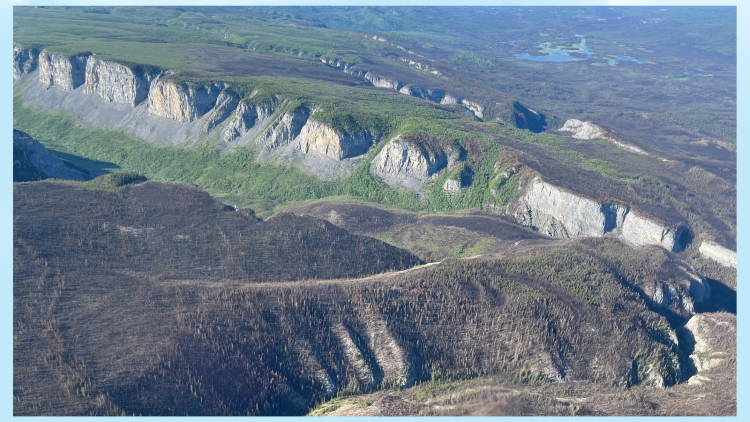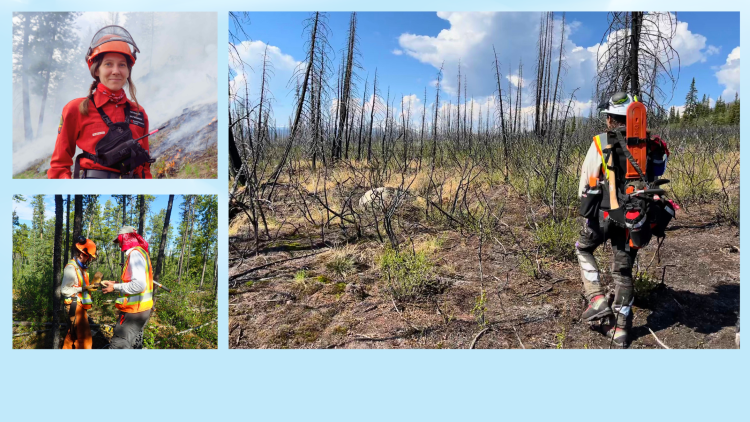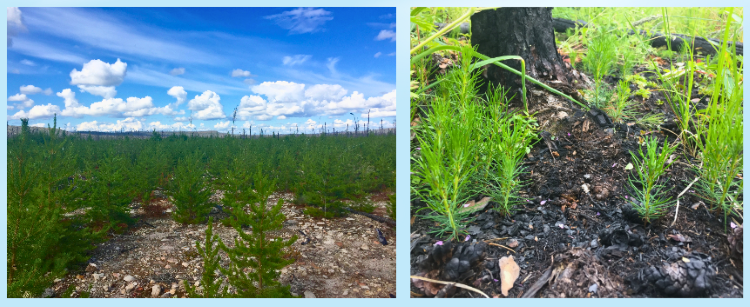The story of North American forests is one of resilience, adaptation, renewal and hope.
January 2024
If you hike or stroll through one of Canada’s northern forests, you might experience a world of towering trees, cool shade filled with the scent of pines and spruces — home to many different plants and animals of all shapes and sizes. But Ellen Whitman, a wildfire research scientist at the Canadian Forest Service, sees things through a different lens. What she notices is a landscape quietly and gradually transforming.

The impact of a recent fire near Nahanni National Park Reserve, about 500 kilometres west of Yellowknife, Northwest Territories. Photo: Ellen Whitman.
A very different place
Ellen sheds some light on this phenomenon. “Globally, we’re noticing a change in forest biomes as they shift away from mature forests toward shrub and herb-dominated ecosystems,” she notes. “Head up to the Northwest Territories and you’ll find parts of forests that have been utterly transformed. The towering jack pines have surrendered their reign to grasses and stunted aspens, armed with light seeds that can be carried on the wind,” she says. The small, forested area that caught her eye back then is “a very different place now.”
She first became interested in Wood Buffalo National Park and the southern Northwest Territories in 2014, after a major wildfire season. She worked with two other NRCan scientists, Marc-André Parisien and Dan Thompson, along with wildfire expert Mike Flannigan of Thompson Rivers University. The goal? To compare several paired forested areas with similar climate, pre-fire vegetation and soil conditions. One of each pair had experienced two fires in a short time, also known as short interval reburns. The other had a longer period of regrowth between fires. The differences were significant. The scientists published their findings in the international science journal Nature, noting that, in places with short interval reburns, open stands of aspens dominated in place of dense conifer forests, and the understorey vegetation beneath the trees consisted of sparse shrubs and grasses.

Clockwise from top left: Ellen Whitman (photo: Kira Hoffman). Research scientist Dan Thompson walking with a chain saw to examine the impact of wildfires near Nahanni, Northwest Territories (photo: Denyse Dawe). Fieldworkers examine tree samples. (photo: Sean Parks USDA Forest Service).
More recently, Ellen and a team of researchers studied wildfire and climate trends in northwestern boreal forests. Looking mainly at Alberta, using historical data from 1970 to 2019 their research findings were notable: the annual number of large wildfires and the number of extreme short interval reburns both increased as the climate grew warmer and drier. This research supports the growing body of evidence that increasing fire activity affects not just the local environment, but the overall ability of the forest to regenerate.
This transformation is most evident in western and northern parts of Canada and in the southwestern United States. In some reburned areas, you can still spot trees, but they’re less dominant than in neighbouring forests, creating a more open, almost savanna-like appearance. Savannas, which are common in Africa and Australia, have a drier climate characterized by rolling grasslands scattered with shrubs, trees and occasional patches of forest.
Key players: wildfires and climate
So, what exactly is happening? Ellen breaks it down: “Climate change and increasingly severe wildfires are key players in this transformation. While they might not be the sole driver, they’re certainly capable of leading to this shift.”
Climate stresses come in the form of droughts, floods and warmer than usual weather patterns. When it’s drier than usual, wildfires tend to happen more often and become more severe.
What’s more, areas recently burned by fires lack nearby sources of seeds for trees to regrow. Sometimes it’s because the burned patch is so vast that the seeds would have a long way to travel. In other cases, it’s because the seed bank, which refers to the dormant seeds that normally exist in the soil, was destroyed in the fire. And even if a tree seedling manages to take root, it might struggle with unusually hot and dry weather. Simply put, they may not survive in today’s climate, which is different than it was when forests first took root decades and centuries ago.
A patch of forest showing aspens growing where old-growth tree species were once dominant in an old reburn area.
Long term shifts
“There are ongoing long-term shifts away from old-growth tree species like spruce, toward shorter-lived ones like pine or aspen,” Ellen points out.
However, none of this is new, exactly. The balance of tree species in North American boreal forests have shifted many times since the last major ice age 11,700 years ago, as temperatures and wildfire patterns change. Wildfires are a natural phenomenon and can help forests thrive. “Fires can spark overdue regeneration, particularly where they’ve been artificially suppressed,” she points out. “Forests aren’t inherently superior to other ecosystems, and sometimes a bit of rebalancing is needed where they have invaded, such as in some former grasslands.”
Resilience: a race to keep up?
Forests and wildlife can be resilient. Trees have long been adapted to wildfires and changing conditions, while animals can find safer havens. Mature trees have great inertia, which means even if the climate changes fast, they will most likely persist. But Ellen notices a crucial shift. The speed of change is picking up and ecosystems have less time to recover between wildfires. She explains: “there’s some evidence they’re starting to lose the ‘safe operating space’ they need to be resilient to disturbances.”
The story gets more complex when the wider ecological impact is considered. Wildfires create a ripple effect. “In North America, the loss of large, old-growth trees could have consequences for creatures uniquely developed to thrive in mature forests,” notes Ellen. These include specialist species like martens and fishers, members of the weasel family that make their dens inside tree hollows, for example. Beyond that, wildfires impact human social and economic values by reducing carbon storage, altering water dynamics and even affecting how much sunlight the planet can absorb.

A forest undergoing renewal. Left: A grove of young pines thrives in a post-wildfire burn area. Right: Yearling pine seedlings take root.
Hope, renewal, adaptation
The story of forests is not just a tale of loss, but one of renewal and adaptation. “We can expect most of our burned area to recover fine,” says Ellen. The reality is forests evolve. They may not always resemble the forests we’re used to seeing or respond how we expected. But different combinations of native and non-native plants are sure to fill the voids.
Ellen’s research serves as a reminder that our own actions have far-reaching impacts on the ecosystems we share. There are ways to adapt and mitigate these changes. Land managers can use strategies like fuel treatments and prescribed burning to lessen the severity and spread of wildfires. On a personal level, we can contribute by reducing energy use and cutting down on greenhouse gas emissions. The key is to find a balance that lets nature thrive, while providing the essential ecosystem services we rely on. There is still much work to do be done as Ellen and other wildfire scientists continue their quest to understand the drivers and consequences of changes unfolding in our forests.
Explore:
More about Ellen Whitman’s work on ResearchGate
Wildland fire management and research (NRCan)
Tracking forest change and recovery in Canada (NRCan)
Canada’s record-breaking wildfires in 2023 (Simply Science article)